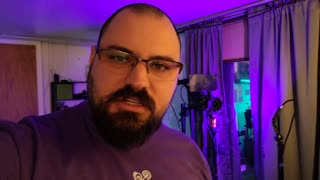Premium Only Content

I want to break free. Gorrila in need.
I want to break free, Animals in captivity in the zoo, if you go to a zoo you go to a prison of animals.
But with endangered species, it may be their last hope for their species' survival.
Like giant bamboo forest Teddy Bears, pandas top the must-see list at the San Diego Zoo. What many visitors don't realize is research there contributed to a global baby boom, with 300 pandas in zoos and breeding centers.
"Modern zoos are very different even from zoos 20, 30 years ago," said Dr. Robert Weise, Ph.D., Chief Life Sciences Officer at the San Diego Zoo Global.
Far away from visitors, San Diego Zoo Global conducts 140 conservation projects in 80 countries.
"Our mission is to bring species back from the brink of extinction," Weise said. "Yes, we have a zoo where people can come and have a great day and enjoy a day out with their families and see animals from around the world. But our real mission is to save species from extinction."
The need could scarcely be more urgent in the midst of what many scientists consider the earth's sixth great mass extinction. With the world population of humans topping 7 billion, man claims more habitat from wild creatures just for the needs of agriculture.
"Continuing to feed those populations is a sustainable issue because it has to be grown somewhere," said Randy Rieches, Curator of Animals at the San Diego Zoo. "And to do that you're taking up land that wildlife is on."
Wildlife experts estimate poachers take about 100 elephants a day. The rhinoceros is killed for its horns because of the mistaken belief in some parts of the world that they have medicinal value.
"We're actually having more rhinos poached each year than born," Rieches said.
A partnership between San Diego Zoo Global and the Audubon Institute aims to breed other animals whose numbers suffer in the wild, and often, in zoos.
In the Audubon Species Survival Center on the New Orleans west bank, they will build large paddocks - some 40 acres - and allow species like giraffe and eland more space.
"We're looking at animals across the world to make sure that we don't lose some of these species," said Joel Hamilton, General Curator at the Audubon Zoo.
Consider the success at the sprawling San Diego Zoo Safari Park, where animals traditionally seen in zoos live on 900 acres. A separate adjacent 900 acres hosts animals native to California.
Southern white rhinos rarely bred in captivity until the park opened in the early 1970s. Curators say with all that extra space, animals adopt a herd mentality and 94 rhinos have been born at the Safari Park. The architects of this plan, both in New Orleans and in San Diego, believe it could be a model for zoos around the country, especially as the role of zoos in the survival of species evolves. While the partnership eventually hopes to work with about 40 species, the two zoos could provide the template for others that might avoid the startup headaches and greatly expand the number and variety of species.
"Then, we could duplicate this model in different parts of the country with different habitat types," Hamilton said.
Hamilton says that could range from arid habitats in places such as Arizona to temperate climates in the northern parts of the country.
"Other zoos may take a different route," Weise said. "They may go with exotic cats or they might go with reptiles. Every institution will take kind of their expertise."
Early zoos were one dimensional, barely more than prisons for living creatures put on display in captivity.
While some animal rights activists still dispute the value of exhibiting wildlife, there is no question zoos have dramatically changed their focus.
"It's very ironic when you think of where zoos were when they started," Rieches said.
San Diego plays a critical role in breeding and releasing condors, which became extinct in the wild in the late 1980s. Today, they number more than 400 birds.
"I would not say that 400 is viable," Rieches said, "but if we continue to breed the numbers that we are and have the survivability of condors in the wild, I do think that they will become sustainable."
Audubon is one of two facilities raising Mississippi Sandhill Cranes. Without that effort, the outlook for the cranes would be bleak.
"They probably wouldn't exist," Hamilton said.
Until last year, San Diego was home to a much-celebrated rhino named, ironically, Nola.
The 40 year old's death in December left just three of her kind in the world in the subspecies of northern white rhino.
However, there may be hope for the species in a research facility at the Safari Park.
There, liquid nitrogen containers hold cells from Nola, 18 other rhinos, and 10,000 individual animals comprising more than 1,000 species.
Nicknamed the "Frozen Zoo," the facility was started strictly as a research facility.
"Now, we realize 40 years later these cells can be turned into stem cells, or they can be used for cloning," said Dr. Oliver Ryder, Ph.D, Director of Genetics at the San Diego Zoo Institute for Conservation Research.
Ryder explains those cells could be directed to produce germ cells, the sperm and egg cells that facilitate reproduction.
Germ cells have been used for in vitro fertilization in mice, which produced mouse embryos that grew up to reproduce themselves.
Can essentially the same technique be used in endangered species?
"I hope so," Ryder said, "because it's going to be the only way that we can save some species, like the northern white rhino.
Researchers concede scaling up from a mouse to a five-thousand pound rhinoceros presents challenges.
However, Ryder believes within a decade the work there could produce a rhino baby.
"I believe that we should try," Ryder said. "I believe that we shouldn't turn our back and go, 'too bad, too late, too sad.'"
Success could pose a whole new set of challenges for the handling of endangered species.
"With some species, there is no wild to transfer them back to," Rieches said.
He would be reluctant to release any northern white rhino because the reality is they cannot be protected.
"The last thing we'd want to do is put animals back just to be slaughtered.
Rieches believes that sobering reality adds to the role of zoos as a safety net.
"It truly is the only hope for some species today to be in zoos."
-
 3:23
3:23
GearSeedZero
4 years agoI Want To Break Free solo guitar cover
27 -
![Need a break from life [GMG Originals]](https://1a-1791.com/video/s8/1/j/y/O/R/jyORb.0kob-small-Need-a-break-from-life-GMG-.jpg) 0:15
0:15
SharedIllustration
4 years agoNeed a break from life [GMG Originals]
344 -
 4:26
4:26
Legacy Studio
4 years agoI need a break...
67 -
 0:53
0:53
rebuildingthegates
4 years ago $0.17 earnedSometimes You Need a Break!
1.76K2 -
 15:39
15:39
Jack Murphy Live
4 years agoTo Break FREE You Must Become UNCANCELLABLE
1871 -
 2:09:22
2:09:22
Robert Gouveia
4 hours agoTrump WINS Appeal! 🚨 Letitia James BLOWN OUT! Biden Scandal BOMBSHELL!
8.84K12 -
 3:15:52
3:15:52
Barry Cunningham
3 hours agoBREAKING NEWS: PRESIDENT TRUMP ON PATROL IN WASHINGTON D.C.
32.1K11 -
 LIVE
LIVE
LFA TV
14 hours agoLFA TV ALL DAY STREAM - THURSDAY 8/21/25
778 watching -
![[your]NEWS - Become a PAID Journalist - With Sam Anthony](https://1a-1791.com/video/fww1/68/s8/1/i/4/a/b/i4abz.0kob-small-yourNEWS-Become-a-PAID-Jour.jpg) LIVE
LIVE
Kat Espinda
16 hours ago[your]NEWS - Become a PAID Journalist - With Sam Anthony
90 watching -
 LIVE
LIVE
megimu32
2 hours agoOTS: Pimp My Ride LOL - Insane Mods & Car Stereo Nostalgia
122 watching